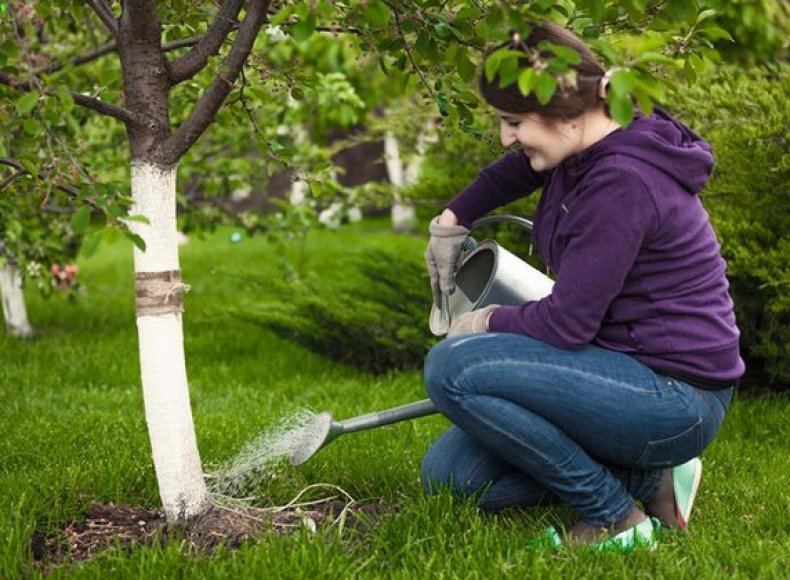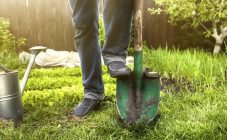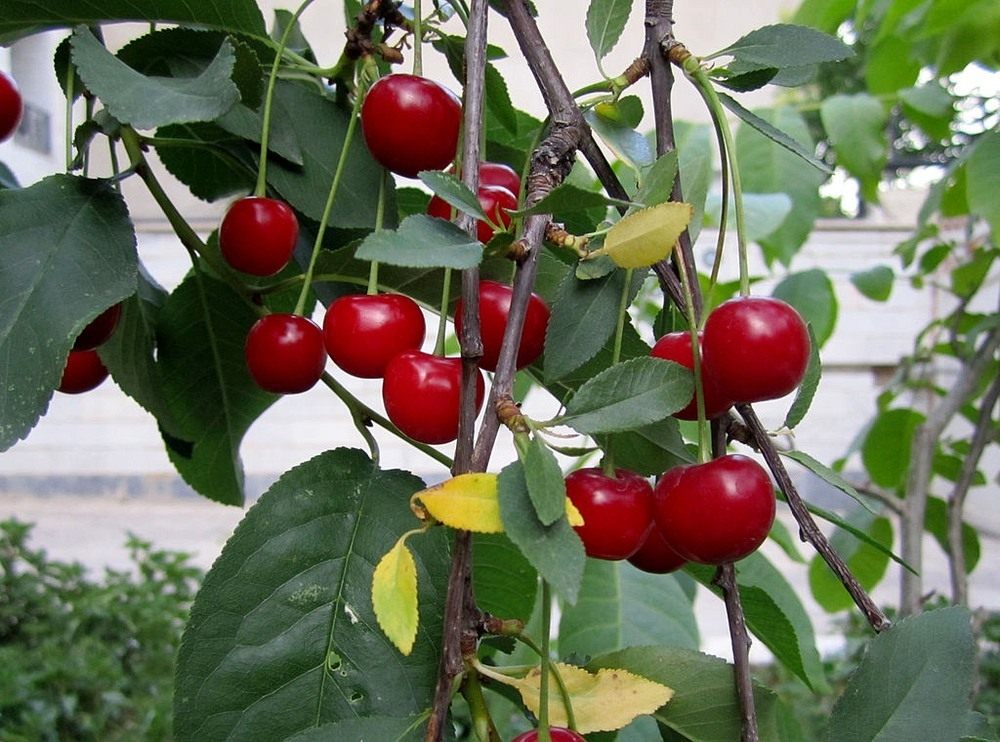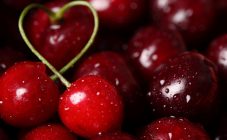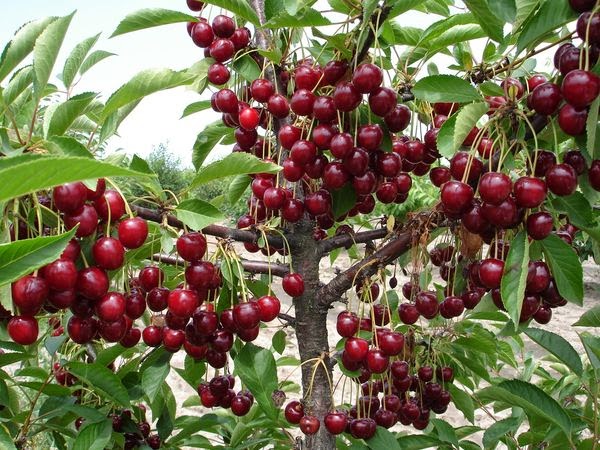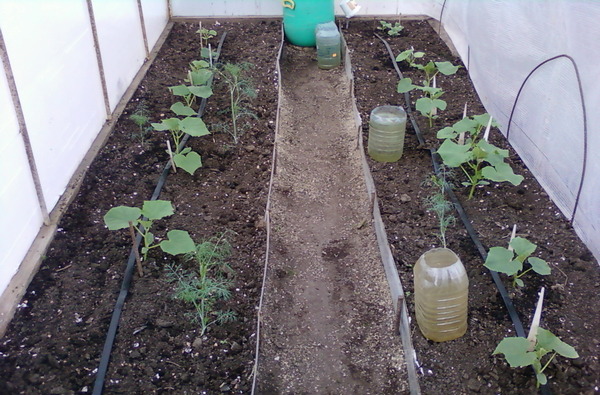Content:
Irrigation of cherries is an integral agronomic method of achieving high and stable crop yields. For this technique to be effective, you need to know how to water the cherries, how much moisture you need, etc.
A brief description of cherry as a culture
Cherry is a perennial fruit crop, belongs to the genus Cerasus Mill. Cherry plants are divided into treelike and bushy ones according to the shape of the aboveground part. Treelike cherries are single-stemmed trees with a height of 3-4 m or more. Fruiting in them is concentrated on bouquet branches, the laying of which depends on the length of the growth. Growth buds are located on long annual branches (30-40 cm). The next year, bouquet twigs and growth shoots are formed from them. Treelike cherries are less prone to exposing branches than bushy ones.
Bushy cherries are often multi-stemmed, 1-3 m high. Their crown is spreading, drooping, with numerous thin branches. Fruiting on the growths of the last year and depends on its length. Weak growth reduces the harvest of the future andsubsequent years, since group and growth buds are not laid on short shoots. With good growth, 30-40 cm long, lateral growth and group buds are laid, branching improves, the total number of buds increases and the yield increases.
The most common varieties in our country are:
- Vladimirskaya is an old variety of unknown origin, widespread in Russia. Zoned across the North-West, Central, Volgo-Vyatka, Central Black Earth and Middle Volga regions.
- Youth. Obtained in VSTISP (Moscow) from crossing the varieties Lyubskaya and Vladimirskaya. Zoned in the Central Region.
- Turgenevka. The variety was bred in VNIISPK (Orel). Seedling from free pollination of the Zhukovskaya variety. Zoned in the Central, Central Black Earth and North Caucasian regions.
Watering cherries
The irrigation procedure for cherry trees has a number of specific features that depend on the growing season, weather and climatic conditions and plant age.
Saplings
To get a good harvest, you need to know how to water your cherry seedlings. The very first irrigation is carried out immediately after planting in open ground in spring or autumn. In the near-stem sector of the plant, at a distance of about 50 cm from the seedling, a shallow circular groove (no more than half a meter deep) is dug, into which 2-3 buckets of water are then poured. When the liquid is absorbed into the soil, it is necessary to lightly compact the soil in order to keep moisture in the soil as long as possible. Following this, it is necessary to sprinkle the soil around the seedling with mulching material (dried grass, compost, humus). It will also trap moisture in the soil and reduce water consumption.
At this stage, it is important to irrigate no later than a few hours after planting the seedling. In case of delay, most plants die. Those seedlings that survive become weak, form few fruits, suffer more from low temperatures, diseases, pests.
The first watering is recommended with garden watering cans. This contributes to the rational distribution of moisture in the soil.
If the summer period is characterized by a moderate amount of precipitation, then irrigation is carried out only with a strong drying out of the upper soil layer. In rainy periods, watering is allowed to stop altogether.If the season turned out to be dry, then irrigation is required here more often. During each procedure, it is necessary to spend 10-15 liters of warm settled water. The soil must be moistened to the depth of the planting hole so that the water reaches the bottom roots. When adding moisture to the near-stem sector, care must be taken to ensure that the root collar does not get wet. If the roots are exposed under the pressure of water, then they need to be sprinkled with earth.
Watering is recommended in the evening, closer to sunset. This is necessary so that the water remains in the hole as long as possible.
Cherry 2-5 years
At this age, watering cherries in spring and summer loses its importance. Watering is needed in the following cases:
- high fever, intense heat;
- drought, long absence of rain;
- regular drying out of the soil due to growing in a sunny area.
When asked whether it is possible to water a cherry during flowering, you should answer what you need, and do it when it blooms. Irrigation is also required during the formation of ovaries. If there is a lack of moisture, the next watering should be carried out during the pouring of the fruits, but no later than two weeks before harvest. Ultimately, this can cause the fruit to crack.
As a rule, cherry blossoms are not watered in spring, since at this time of the year the trees are fully provided with moisture. The time and mode of the procedure coincides with those of plants of the first year of life.
The regularity of watering at this time is reduced. At this age, the cherry forms a sprawling root system that needs full breathing. Excess water in the ground leads to disruption of this process. The roots begin to rot, which leads to the death of the plant.
When dry leaves appear, it is necessary to loosen the soil in the near-stem sector as soon as possible. After loosening, the plant will immediately respond positively and after a certain time will fully recover.
For watering, it is recommended to dig two circular grooves under the crown at a distance of half a meter from each other. The depth of the first, which is closer to the tree, should be no more than 8-10 cm, so as not to damage the root system. The second groove may be deepened up to 20 cm.
Cherry 5-15 years
Trees of this age have even less need for irrigation. Water when the cherry is about to bloom and in very dry weather.
Also for mature trees, autumn watering is of particular importance. Irrigation begins immediately after the completion of leaf fall. Depending on the region, this period falls on the end of September - the first half of October. If possible, irrigate the plant with two liters of water daily for a week. This procedure improves the preparation of cherries for the winter period and protects the wood and plant roots from frost damage. This is especially important in view of the fact that cherries and other stone fruits have poor winter and frost resistance in comparison with other fruit plants.
Cherries over 15 years old
For plants at this age, it is recommended to combine irrigation with fertilizing with mineral fertilizers. The effectiveness of this method increases if you dig 5-6 small holes no more than a quarter of a meter deep in different parts of the near-stem sector, where you put nutrients and fill them with soil. After that, a sprinkler should be placed on the plot or in the garden so that it can sufficiently moisten the soil around the tree. The effect of such feeding lasts up to three years.
Sprinkling
This procedure is often performed on leafy cherry crowns in dry and hot conditions. Both young seedlings and mature trees respond positively to it. It is recommended to spend in the evenings or early in the morning.The weather must be cloudy. During the day and in hot weather, it is forbidden to arrange sprinkling, since water droplets on the surface of the leaf blades will provoke severe burns.
In addition to saturation with moisture, sprinkling also strengthens winter hardiness, which is important before severe frosts. The effectiveness of the procedure will begin to manifest itself immediately after a sharp temperature jump. In this case, sprinkling is carried out late in the evening and extended overnight until dawn.
Cherry care
The most common and harmful diseases of cherries include:
- coccomycosis;
- moniliosis;
- clasterosporium disease;
- verticillosis;
- milky shine, etc.
Cherries are affected by pests such as:
- cherry fly;
- cherry aphid;
- cherry weevil;
- slimy sawfly;
- grub larvae, etc.
Pest and disease control most often involves treatment with appropriate fungicides and insecticides. In some cases (in the presence of viral diseases), the only measure of protection is cutting the tree and removing it from the site. This will avoid spreading the virus to the rest of the field or garden.
Cherry is responsive to the application of mineral and organic fertilizers. It is recommended to add potassium and phosphorus during the autumn digging of soil. Complex preparations and nitrogen should be used in the spring during the first soil loosening.
With proper and timely watering and other agrotechnical measures, it is possible to get a good harvest of cherries. It is necessary to pay more attention to these techniques, take into account the timing of watering cherries and the volume of liquid.

